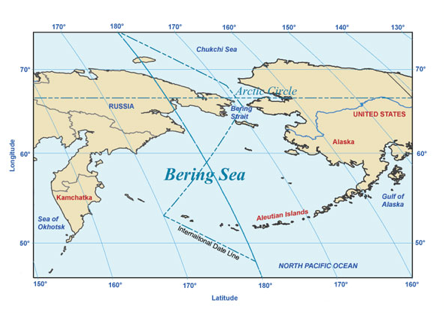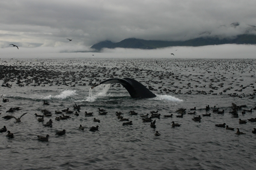
by Nathan Jones
May 25, 2008. Moss Landing, California – The Bering Sea is a long way from Moss Landing, California. It’s a long way from most anywhere, actually. To begin my summer of field work, I must first fly from San Francisco, California to Seattle, Washington. In Seattle I will change planes and fly to Anchorage, Alaska. From Anchorage I’ll catch a small propeller plane and fly low over the mountains, glaciers, and the vast wilderness of Southwest Alaska to stop briefly in King Salmon, where we will refuel, and then continue on out along the foggy Aleutian Island chain to land in Dutch Harbor, Alaska. I will then board a research vessel that will motor for fifteen hours out into the Bristol Bay portion of the Bering Sea and there, at last, I will begin my work. It will probably take me three long days.

Humans are not the only animals that eat fish, of course! Seabirds flock by the millions to feed on fish in the Bering Sea, and also on energy-rich krill (tiny crustaceans, similar to a shrimp). These krill grow to become so numerous in summer that they form dense undersea clouds that can stretch for miles. Krill, known to scientists as euphausiids, are eaten by fish; in fact, we feed them to our own pet goldfish, in dried and flaked form! They are also the favorite food of many whales, which use their thick baleen plates to strain these tiny creatures from the water in huge, lunging mouthfuls.

Because they like to eat similar kinds of food, whales and seabirds can oftentimes be seen congregating to feed together in productive areas that contain especially large amounts of fish and euphausiids. Such places are usually characterized by turbulence and the mixing of cold(er) and warm(er) ocean water. What is it about the turbulent combination of cold and warm water that attracts the euphausiids and fish?
During the next two months I will spend most of my time on the ocean. I will be taking special interest in these foraging hotspots, trying to learn more about how seabirds find and exploit them.
If you’re interested in learning more, Nate recommends the following websites:
To learn more about the North Pacific/Bering Sea where Nate will be working, check out the National Pacific Research Board, Bering Climate, North Pacific Ocean Theme Page, and Arctic Change.
To learn more about wildlife, check out these resources for marine mammals, seabirds and fish.

